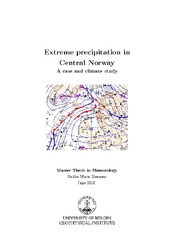Extreme precipitation in Central Norway. A case and climate study
Master thesis
Permanent lenke
https://hdl.handle.net/1956/7108Utgivelsesdato
2010-06-01Metadata
Vis full innførselSamlinger
- Geophysical Institute [1187]
Sammendrag
An extreme precipitation event occurred over Central Norway at the end of January to the beginning of February 2006. The heavy precipitation in addition to high temperatures lead to snow melt and increased run-off, which produced flooding and landslides that caused considerable damage to infrastructure and loss of human life. A numerical weather prediction tool is used to model the flow pattern on synoptic and mesoscale to find the cause for the generation of the high precipitation rates. Forced lifting of warm moist air due to strong perpendicular winds over the mountains in Central Norway is found to be the main cause. A second topographical effect is the blocking of the flow by the mountain ridge in Southern Norway. The blocking causes a deflection and enhancement of the forcing over Central Norway, and leads to more precipitation. Vertical motion described by the quasi-geastrophic theory is found to be of limited importance. The warm moist air over Trøndelag during the event is calculated backwards to the subtropics. An investigation of the predictability of the event reveals a sensitivity in a baroclinic zone in an area south of Newfoundland upstream of the event. A likely effect of the global climate change is a shift in the frequency of extreme events, and an increase in combined extreme events like the one described in this thesis. Results from a global climate model are downscaled with a higher resolution regional climate model in order to acquire a description of the frequency of similar events in a future greenhouse gas scenario. There is found an increase in high temperature events during winter, and an increase in frequency for similar extreme precipitation events during the whole year and winter.
